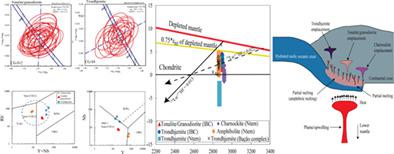当前位置:
X-MOL 学术
›
Geolog. J.
›
论文详情
Our official English website, www.x-mol.net, welcomes your
feedback! (Note: you will need to create a separate account there.)
Petrology, geochemistry, and zircon U–Pb-Lu–Hf isotopes of granitoids from the Ivindo Basement Complex of the Souanké Area, Republic of Congo: Insights into the evolution of Archean continental crust
Geological Journal ( IF 1.4 ) Pub Date : 2021-07-22 , DOI: 10.1002/gj.4219 Chesther Gatsé Ebotehouna 1 , Yuling Xie 1 , Kofi Adomako‐Ansah 2 , Yunwei Qu 1
Geological Journal ( IF 1.4 ) Pub Date : 2021-07-22 , DOI: 10.1002/gj.4219 Chesther Gatsé Ebotehouna 1 , Yuling Xie 1 , Kofi Adomako‐Ansah 2 , Yunwei Qu 1
Affiliation

|
The Ivindo Basement Complex (IBC) comprises the largest exposure of Meso- to Neoarchean rocks in the northwestern segment of the Congo Craton in the Republic of Congo. The age and petrogenetic setting of the IBC are not clear due to a lack of detailed studies. In the Souanké area, which is on the northeastern margin of the IBC, the most exposed rocks are charnockites, tonalite/granodiorite, and trondhjemite. Based on geology, geochemistry, and zircon U–Pb-Lu–Hf isotopes, this paper constrains the petrogenesis and tectonic significance of these granitoids for the evolution of the IBC. Poor-quality zircons did not allow for age determination and Lu–Hf isotopic characteristics for the charnockite. However, zircon U–Pb dating of the tonalite/granodiorite and trondhjemite yielded the weighted mean 207Pb/206Pb ages of 2,895 ± 9.4 Ma and 2,889 ± 9.2 to 2,897 ± 5.0 Ma, respectively. Zircon Hf isotopic (εHf[t]) values of +1.22 to +4.55 and Th/La >0.12 for the tonalite/granodiorite and trondhjemite indicate that these rocks were derived from partial melting of an older mafic reservoir (TDM2 ages range from 3,028 to 3,230 Ma), possibly triggered by mantle upwelling or plume activity. All the studied IBC granitoids are peraluminous, calcic-alkalic, relatively sodium-rich (Na2O/K2O > 1), and contain low Ni, Cr, and Yb contents, with strongly fractionated rare-earth element (REE) patterns. On standard-normalization diagrams, the IBC rocks exhibited similar distribution patterns in the trace element geochemistry as average Archean TTGs, except for high U, Nb, and Ta concentrations in the IBC trondhjemite. These high values may indicate amphibole dehydration melting (which sequesters Ta and Nb) at low-pressure conditions at the source for the trondhjemite generation, while the other IBC rocks experienced high-pressure melting. The 2,900–2,800 Ma tectono-thermal event registered in the IBC from our study was also previously documented for the Ntem Complex TTGs of Cameroon (northwestern equivalent of the IBC) and elsewhere in other cratons such as in the Bação Complex (São Francisco Craton) of Brazil and, therefore, represents an important period for the Archean crustal evolution in geologic history.
中文翻译:

刚果共和国 Souanké 地区 Ivindo 基底复合体花岗岩的岩石学、地球化学和锆石 U-Pb-Lu-Hf 同位素:对太古代大陆地壳演化的洞察
Ivindo 基底复合体 (IBC) 包括刚果共和国刚果克拉通西北部中古至新太古代岩石的最大暴露。由于缺乏详细的研究,IBC 的年龄和成因环境尚不清楚。在位于 IBC 东北缘的 Souanké 地区,出露最多的岩石是炭黑长石、闪长岩/花岗闪长岩和长长闪长岩。基于地质学、地球化学和锆石 U-Pb-Lu-Hf 同位素,本文限制了这些花岗岩的岩石成因和构造对 IBC 演化的意义。劣质锆石无法确定硬镁石的年龄和 Lu-Hf 同位素特征。然而,锆石 U-Pb 测年结果显示了207 Pb/206 Pb 年龄分别为 2,895 ± 9.4 Ma 和 2,889 ± 9.2 至 2,897 ± 5.0 Ma。锆石 Hf 同位素 ( ε Hf [ t ]) 值为 +1.22 至 +4.55 且 Th/La > 0.12 的辉长岩/花岗闪长岩和长长闪长岩表明这些岩石源自较旧的基性储层的部分熔融(T DM2年龄范围为3,028 至 3,230 Ma),可能由地幔上涌或羽流活动触发。所有研究的 IBC 花岗岩都是过铝质、钙碱性、相对富含钠 (Na 2 O/K 2O > 1),并且含有低 Ni、Cr 和 Yb 含量,具有强分馏的稀土元素 (REE) 模式。在标准归一化图上,IBC 岩石在微量元素地球化学中表现出与平均太古代 TTG 相似的分布模式,除了 IBC 长闪长岩中的高 U、Nb 和 Ta 浓度。这些高值可能表明角闪石在低压条件下发生脱水熔化(其螯合 Ta 和 Nb)以生成长长闪长岩,而其他 IBC 岩石经历了高压熔化。我们的研究在 IBC 中记录的 2,900-2,800 Ma 构造热事件之前也被记录在喀麦隆的 Ntem Complex TTG(相当于 IBC 的西北部)和其他克拉通的其他地方,例如 Bação Complex(圣弗朗西斯科克拉通)巴西,因此,
更新日期:2021-09-02
中文翻译:

刚果共和国 Souanké 地区 Ivindo 基底复合体花岗岩的岩石学、地球化学和锆石 U-Pb-Lu-Hf 同位素:对太古代大陆地壳演化的洞察
Ivindo 基底复合体 (IBC) 包括刚果共和国刚果克拉通西北部中古至新太古代岩石的最大暴露。由于缺乏详细的研究,IBC 的年龄和成因环境尚不清楚。在位于 IBC 东北缘的 Souanké 地区,出露最多的岩石是炭黑长石、闪长岩/花岗闪长岩和长长闪长岩。基于地质学、地球化学和锆石 U-Pb-Lu-Hf 同位素,本文限制了这些花岗岩的岩石成因和构造对 IBC 演化的意义。劣质锆石无法确定硬镁石的年龄和 Lu-Hf 同位素特征。然而,锆石 U-Pb 测年结果显示了207 Pb/206 Pb 年龄分别为 2,895 ± 9.4 Ma 和 2,889 ± 9.2 至 2,897 ± 5.0 Ma。锆石 Hf 同位素 ( ε Hf [ t ]) 值为 +1.22 至 +4.55 且 Th/La > 0.12 的辉长岩/花岗闪长岩和长长闪长岩表明这些岩石源自较旧的基性储层的部分熔融(T DM2年龄范围为3,028 至 3,230 Ma),可能由地幔上涌或羽流活动触发。所有研究的 IBC 花岗岩都是过铝质、钙碱性、相对富含钠 (Na 2 O/K 2O > 1),并且含有低 Ni、Cr 和 Yb 含量,具有强分馏的稀土元素 (REE) 模式。在标准归一化图上,IBC 岩石在微量元素地球化学中表现出与平均太古代 TTG 相似的分布模式,除了 IBC 长闪长岩中的高 U、Nb 和 Ta 浓度。这些高值可能表明角闪石在低压条件下发生脱水熔化(其螯合 Ta 和 Nb)以生成长长闪长岩,而其他 IBC 岩石经历了高压熔化。我们的研究在 IBC 中记录的 2,900-2,800 Ma 构造热事件之前也被记录在喀麦隆的 Ntem Complex TTG(相当于 IBC 的西北部)和其他克拉通的其他地方,例如 Bação Complex(圣弗朗西斯科克拉通)巴西,因此,











































 京公网安备 11010802027423号
京公网安备 11010802027423号